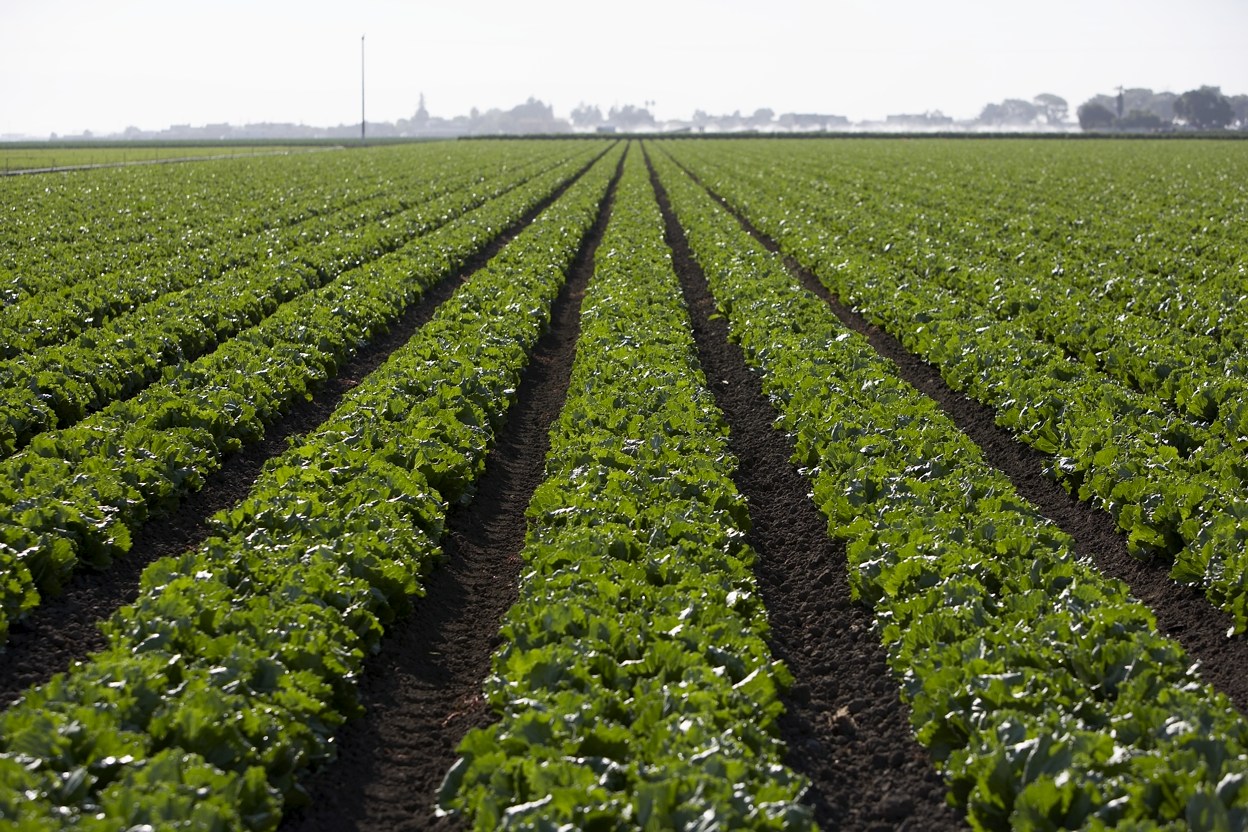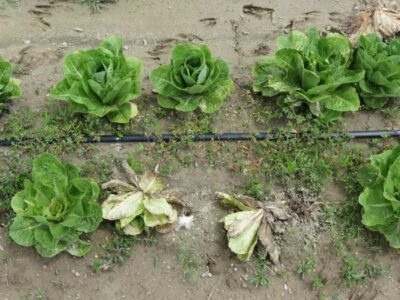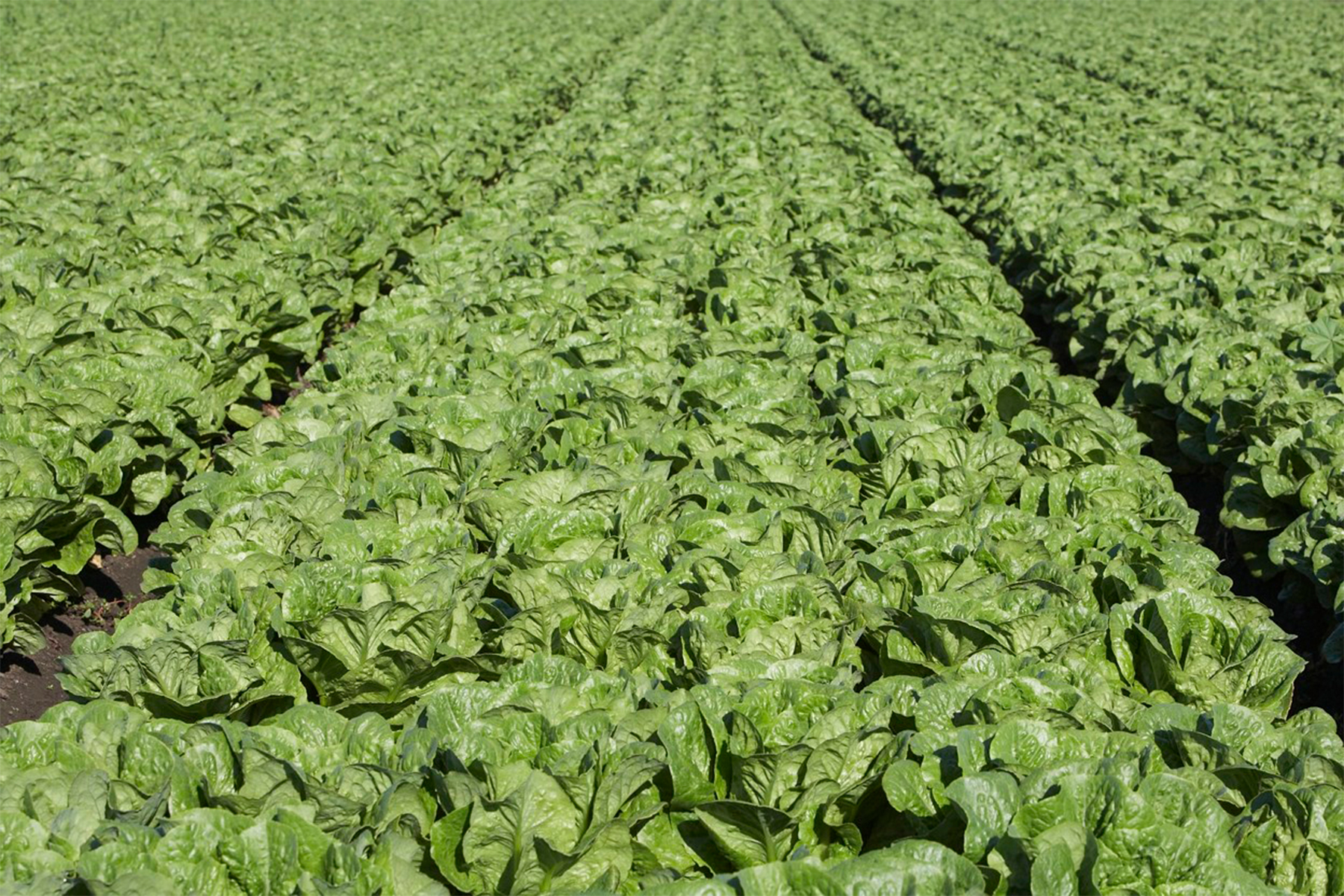
The IR-4 Project helped facilitate a new tolerance for mandestrobin on lettuce, giving growers of leafy greens a much-needed tool to fight fungal disease. This new tolerance was approved by the U.S. Environmental Protection Agency (EPA) on May 12, 2022, adding lettuce to the mandestrobin label. This was the first tolerance based on a petition submitted by IR-4 that has been approved by EPA for Valent U.S.A. Intuity® Fungicide, based on the active ingredient (AI) mandestrobin.
Lettuce is the most widely consumed leafy green in the United States. In 2022, lettuce accounted for nearly one-fifth of the $21.8 billion in revenue received by U.S. growers for vegetable and melon sales. The largest areas for lettuce production within the country are California, Arizona, and Florida. The primary growing area shifts depending on the growing season, as lettuce prefers mild to cool (but not freezing) temperatures.
Lettuce Losses From Sclerotinia
Lettuce drop, caused by Sclerotinia spp. is considered one of the most destructive fungal diseases affecting field-grown lettuce. The soil-borne fungus can cause major crop losses in all types of lettuce and in every region where it is grown. According to the Pryror Laboratory at University of Arizona School of Plant Sciences, crop losses from lettuce drop can reach 75 percent, sometimes eradicating entire fields.
Sclerotinia minor and S. sclerotiorum are the two pathogens that cause lettuce drop. These species can survive in the soil for two to three years without hosts. Wet soil favors disease development for both species. Damaged or senescent lettuce tissue is the most susceptible to infection when the weather is cool and moist. Infection symptoms include a watery, soft rot, white mycelia and sclerotia formation. Where Sclerotinia persists, it is likely to affect lettuce again; crop rotation is encouraged for prevention.
According to Jill Calabro, Product Development Manager for fungicides at Valent U.S.A., “Once leaf emergence occurs and the leaves are pushing through the soil, which could contain the pathogen, the plants can pick up some of the fungal spores.” Additionally, “If environmental conditions favor the pathogen, the spores start growing and can infect plants.”
Effective Control for Sclerotinia

Sclerotinia can be a tough disease to control, especially when it results in crown rot of lettuce plants. Growers have needed additional tools to combat the disease and prevent resistance to existing products, and IR-4 researchers have evaluated the fungicide Mandestrobin as an option.
Mandestrobin is a systemic fungicide that is mobile within plants; it also has translaminar systemic activity moving from the upper leaf surface to the lower leaf surface. This activity provides protection on both sides of the leaves. The mode of action of this fungicide is different than others current available for control of lettuce drop, providing an effective addition to the existing toolbox. Mandestrobin is commonly applied as a foliar application.
“In these production situations, preventive is always best for fungicide applications,” Calabro said. “Mandestrobin is a highly effective fungicide against Sclerotinia. Mandestrobin is labeled for up to two applications on lettuce. The first application is at the two-leaf stage, shortly after leaf emergence. The second application is made 10 days after thinning.”
Expanding the Label
Mandestrobin (FRAC group 11), sold commercially as Intuity, is labeled for several uses, including on grapes and strawberries for Botryis bunch rot/gray mold control, for suppression of powdery mildew, and on canola for Sclerotinia. It shows strong activity against Monilinia, as well as fungi in the Venturia genus and Phomopsis genus.
Working with IR-4, Valent received approval from the EPA in June 2022 to expand the Intuity label to include lettuce. Valent is currently going through the state registration process to add lettuce to Intuity labels.
IR-4’s ongoing collaboration with Canadian colleagues helped propel these steps forward; the mandestrobin tolerance on lettuce results from a joint residue studies with the Canadian Pest Management Center (PMC). These efforts yielded a sharing of regulatory actions between the U.S. EPA and the Canadian Pest Management Regulatory Authority (PMRA), and the establishment of tolerances in both countries—thus avoiding a barrier to commodity trade. IR-4 celebrates these joint successes together with the Canadian PMC.

Stakeholder-Driven Solutions
Jennifer Clarke, Executive Director of the California Leafy Greens Research Program, was encouraged by IR-4 to submit a supporting request to expand the mandestrobin label to include lettuce. The 50-year-old research program works primarily with University of California researchers, county farm advisors, and the USDA agricultural research station in Salinas, CA—all key stakeholders for IR-4.
“The IR-4 support request for mandestrobin did not correspond with any of the research our program was looking at,” said Clarke. “Because our program is leafy greens-focused and mandestrobin is a fungicide that could be used on leafy greens, IR-4 encouraged the program to submit the request.”
Clarke also emphasized that, because specialty crops tend to offer a relatively small financial return when compared to larger-acreage commodities, chemical company registrants are often less driven to add specialty crops to their product labels.
“This is especially the case in California, where it is so costly to add crops. IR-4 is key in helping specialty crop growers gain new chemicals registered for use,” noted Clarke.
Jonathan Sarager, Senior Director at Western Growers, said the expansion of the mandestrobin label for use on other specialty crops would be particularly important for the association’s 2,000 members. These members, who are located in California, Arizona, Colorado and New Mexico, account for half of the country’s fresh fruit and vegetable production.
Looking at lettuce, the majority of what is consumed nationally is grown in Western Growers’ member states—shifting seasonally from Arizona and Southern California in the cooler months (November to April), to Central California in warmer months (April to November) according to USDA.
Sarager highlights that IR-4’s impacts go well beyond the salad bowl for growers in his region. “Western Growers represents the interest of 300+ different specialty crops,” Sarager said. “Our members are benefitting from the work being done by IR-4. For 60 years, IR-4 has been working with the pest control companies to expand their product labels for use on specialty crops.”

David Kuack is a freelance technical writer in Fort Worth, Texas (dkuack@gmail.com).
About The IR-4 Project
The mission of the IR-4 Project is to facilitate regulatory approval of sustainable pest management technologies for specialty crops and specialty uses to promote public well-being. By working directly with local crop growers across the country, IR-4 conducts research and develops data necessary for the registration of pest management tools, ensuring that they are safe for use. To learn more, visit our website.
